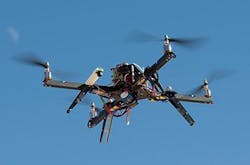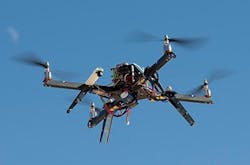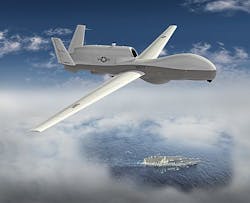Unprecedented growth predicted in unmanned aircraft systems market over next decade
WILMINGTON, Del., 23 Dec. 2014. Revenues for satellite-based unmanned aircraft systems (UAS, also known as drones, unmanned aerial vehicles, or UAVs) in all regions are predicted to grow from $1.3 billion in 2013 to $3.1 billion in 2023, according to Northern Sky Research’s (NSR's) “Unmanned Aircraft Systems (UAS) via Satellite” report.
NSR analysts credit the explosive growth to demand for UAS satellite communications (SatCom) services from governments and international organizations, homeland security, disaster management, and peace-keeping activities.
To date, the UAS industry has primarily been a government and military market with intelligence, surveillance, and reconnaissance (ISR) being the biggest application driving SatCom demand. The decision to withdraw U.S. and NATO troops from Afghanistan greatly affected the market as defense budget cuts were implemented; yet, UAS procurement and transponder lease revenues are forecast to grow past the end of 2015, as the U.S. Government is expected to require more ISR in various regions of conflict.
Civilian UAS applications are set to become a major growth driver starting in late 2016, and early 2017, as airspace regulations are put in place by the Air Transport authorities, such as the FAA.
"In these times of network-centric warfare, UAS is the item every armed force in the world aims to possess in large numbers to gain access to information in faraway locations with as little collateral damage as possible," says Prateep Basu, NSR analyst and report author. "Aside from defense, the civilian UAS applications, such as border and maritime patrol, cargo delivery, and emergency response during disasters, make this market too important and diverse to ignore for long."
New evolving payloads on-board UAS have made bandwidth to and from these airborne platforms the greatest constraint for their operations. NSR expects commercial satellite operators to continue securing a large piece of this market as government-owned capacity struggles to meet demand, and faces infrastructure compatibility issues with existing UAS fleets.
NSR's “Unmanned Aircraft Systems (UAS) via Satellite” report paints a detailed picture of the UAS SatCom market, with analysis of trends on demand, revenues, and growth, based on market segmentation along two different UAS platforms: HALE and MALE, for both defense and civilian government applications.
NSR is an international market research and consulting firm with a core focus on the satellite sector and related industries. Founded in 2000 and with an experienced group of analysts located in all regions, NSR specializes in analysis of growth opportunities across four core sectors: Satellite Communications, Broadcasting & Digital Media, Hybrid & Emerging Applications, and Commercial Space.



